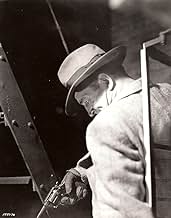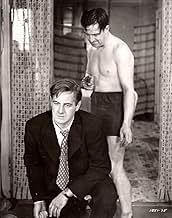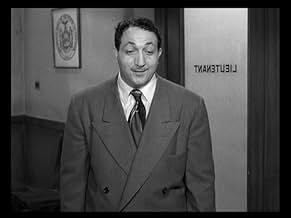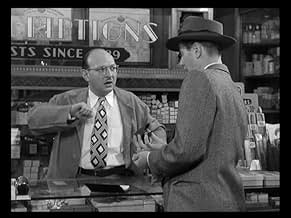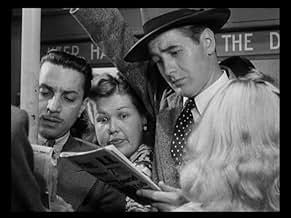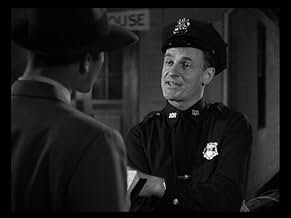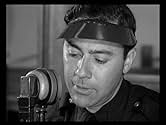ÉVALUATION IMDb
7,5/10
16 k
MA NOTE
Un regard pas à pas sur une enquête pour meurtre dans les rues de New York.Un regard pas à pas sur une enquête pour meurtre dans les rues de New York.Un regard pas à pas sur une enquête pour meurtre dans les rues de New York.
- A remporté 2 oscars
- 3 victoires et 4 nominations au total
Ted de Corsia
- Willy Garzah
- (as Ted De Corsia)
Mark Hellinger
- Narrator
- (voice)
Jean Adair
- Little Old Lady
- (uncredited)
Celia Adler
- Dress Shop Proprietress
- (uncredited)
Janie Alexander
- Girl
- (uncredited)
Joyce Allen
- Shopgirl
- (uncredited)
Beverly Bayne
- Mrs. Stoneman
- (uncredited)
Histoire
Le saviez-vous
- AnecdotesMost of the street scenes were shot on location in New York without the public's knowledge. Photographer William H. Daniels and his uncredited assistant Roy Tripp filmed people on the streets using a hidden camera from the back of an old moving van. Occasionally, a fake newsstand with a hidden camera inside was also set up on the sidewalk to secretly film the actors. Director Jules Dassin hired a juggler to distract the crowds and also hired a man to occasionally climb up on a light post and give a patriotic speech, while waving an American flag to get the crowd's attention.
- GaffesDuring the end pursuit, Garzah walks past a plump, dark-haired lady in a floral dress, pushing a baby in a stroller. As Donahue pursues in a following scene, he passes the same woman, now walking without her baby carriage and her left hand bandaged.
- Générique farfeluThe opening credits are spoken by producer/narrator Mark Hellinger. No credits are seen on the screen.
- ConnexionsFeatured in Visions of Light (1992)
- Bandes originalesSobre las Olas (Over the Waves)
(1887) (uncredited)
Written by Juventino Rosas
Background music for the girls on swings
Commentaire en vedette
An unrealized project of Alfred Hitchcock's was to make a movie about 24 hours in the life of a great city, probably New York. Producer Mark Hellinger enlisted director Jules Dassin to attempt a similar stunt. The result was The Naked City, a slice-of-life police procedural that served as template for the popular television series a decade later. And while the movie is nowhere near the ground-breaking cinematic enterprise that Hellinger promises in his introduction and ceaseless voice-over narration, it's not negligible. With its huge cast (many of them recognizable, even in mute or walk-on roles) and pioneering location shooting on the sidewalks of New York during the sweltering summer of 1947, it nonetheless continues to satisfy. Its documentary aspect outlives its suspense plot.
It opens with two men chloroforming and then drowning a high-profile model in her city apartment (shades of I Wake Up Screaming and Laura). When her cleaning lady finds her next morning, it falls to Detective Lieutenant Barry Fitzgerald, with his heather-honey lilt, and his principal investigator, Don Taylor, to fit the pieces together. Soon into their web flits Howard Duff, an affable, educated loafer with no visible means of support who lies even when the truth would do him no harm. It seems he was on cozy terms with the deceased, even though he's engaged to one of her co-workers (Dorothy Hart). But although Duff's a poor excuse for a human being, nothing seems to stick to him, either. So the police slog on through the broiling day and soupy night, knocking on doors and flashing pictures of the dead girl. Their sleuthing takes them, and us, up and down the hierarchy of the city's eight million souls, from society dames and society doctors to street vendors and street crazies.
While the plot never rises out of the routine, these urban excursions give the movie its raffish texture and remain one of its chief pleasures. This was New York in the dawn of its post-war effloresence, a city where it was still common practice to live comfortably on modest average wages. The gap between East Side apartments and Lower East Side walkups, with the bathtub in the kitchen, doesn't yet seem impossible to cross. And its inhabitants burst on camera with a welter of accents and attitudes. Hellinger and Dassin must have enlisted the services of every character-actor and bit-player in the Tri-State area, and film buffs will have a trivia tournament in trying to pick them out.
The Naked City ends with a chase over hot pavements and a stand-off high up on one of the bridges spanning the East River. It's a great set-piece, of the sort that action movies are all but required to include, but the movie's strength proves more subtle it lies in its collection of sharply drawn vignettes (some of them, to be sure, little more than sentimental shtik). The Naked City is a rarity a major production where the day players outshine the stars.
It opens with two men chloroforming and then drowning a high-profile model in her city apartment (shades of I Wake Up Screaming and Laura). When her cleaning lady finds her next morning, it falls to Detective Lieutenant Barry Fitzgerald, with his heather-honey lilt, and his principal investigator, Don Taylor, to fit the pieces together. Soon into their web flits Howard Duff, an affable, educated loafer with no visible means of support who lies even when the truth would do him no harm. It seems he was on cozy terms with the deceased, even though he's engaged to one of her co-workers (Dorothy Hart). But although Duff's a poor excuse for a human being, nothing seems to stick to him, either. So the police slog on through the broiling day and soupy night, knocking on doors and flashing pictures of the dead girl. Their sleuthing takes them, and us, up and down the hierarchy of the city's eight million souls, from society dames and society doctors to street vendors and street crazies.
While the plot never rises out of the routine, these urban excursions give the movie its raffish texture and remain one of its chief pleasures. This was New York in the dawn of its post-war effloresence, a city where it was still common practice to live comfortably on modest average wages. The gap between East Side apartments and Lower East Side walkups, with the bathtub in the kitchen, doesn't yet seem impossible to cross. And its inhabitants burst on camera with a welter of accents and attitudes. Hellinger and Dassin must have enlisted the services of every character-actor and bit-player in the Tri-State area, and film buffs will have a trivia tournament in trying to pick them out.
The Naked City ends with a chase over hot pavements and a stand-off high up on one of the bridges spanning the East River. It's a great set-piece, of the sort that action movies are all but required to include, but the movie's strength proves more subtle it lies in its collection of sharply drawn vignettes (some of them, to be sure, little more than sentimental shtik). The Naked City is a rarity a major production where the day players outshine the stars.
- bmacv
- 26 juin 2004
- Lien permanent
Meilleurs choix
Connectez-vous pour évaluer et surveiller les recommandations personnalisées
- How long is The Naked City?Propulsé par Alexa
Détails
- Date de sortie
- Pays d’origine
- Langue
- Aussi connu sous le nom de
- The Naked City
- Lieux de tournage
- sociétés de production
- Consultez plus de crédits d'entreprise sur IMDbPro
Box-office
- Brut – États-Unis et Canada
- 2 400 000 $ US
- Durée1 heure 36 minutes
- Couleur
- Rapport de forme
- 1.37 : 1
Contribuer à cette page
Suggérer une modification ou ajouter du contenu manquant

Lacune principale
By what name was La Cité sans voiles (1948) officially released in India in English?
Répondre
